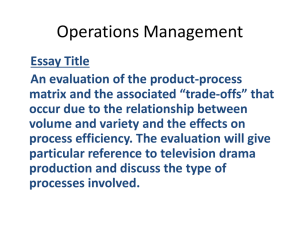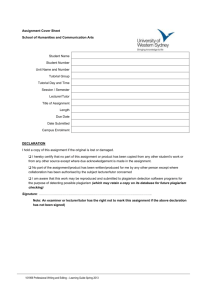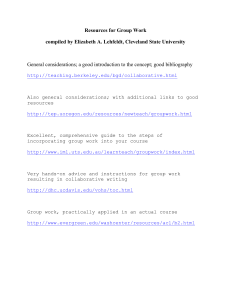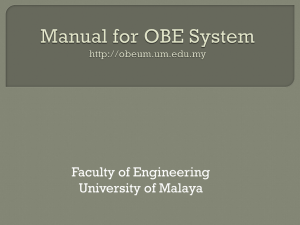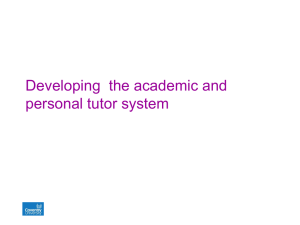Allocating marks when assessing group work (CSHE)
advertisement
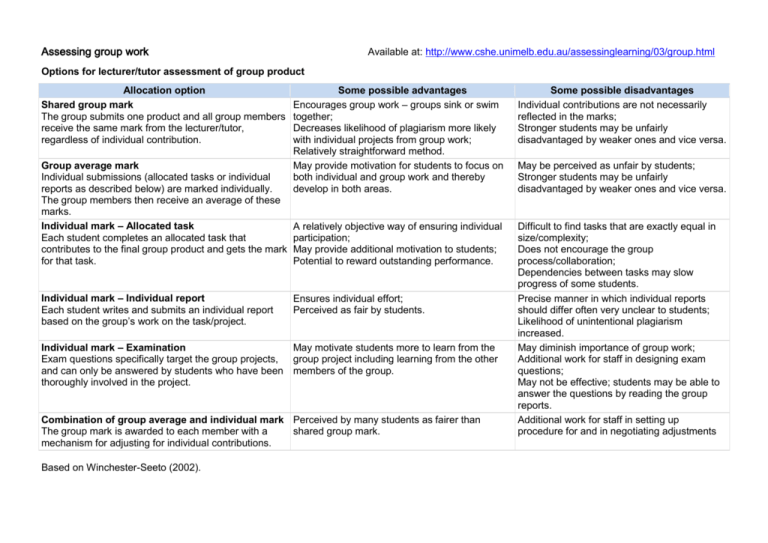
Assessing group work Available at: http://www.cshe.unimelb.edu.au/assessinglearning/03/group.html Options for lecturer/tutor assessment of group product Allocation option Shared group mark The group submits one product and all group members receive the same mark from the lecturer/tutor, regardless of individual contribution. Group average mark Individual submissions (allocated tasks or individual reports as described below) are marked individually. The group members then receive an average of these marks. Individual mark – Allocated task Each student completes an allocated task that contributes to the final group product and gets the mark for that task. Individual mark – Individual report Each student writes and submits an individual report based on the group’s work on the task/project. Some possible advantages Encourages group work – groups sink or swim together; Decreases likelihood of plagiarism more likely with individual projects from group work; Relatively straightforward method. May provide motivation for students to focus on both individual and group work and thereby develop in both areas. Some possible disadvantages Individual contributions are not necessarily reflected in the marks; Stronger students may be unfairly disadvantaged by weaker ones and vice versa. A relatively objective way of ensuring individual participation; May provide additional motivation to students; Potential to reward outstanding performance. Difficult to find tasks that are exactly equal in size/complexity; Does not encourage the group process/collaboration; Dependencies between tasks may slow progress of some students. Precise manner in which individual reports should differ often very unclear to students; Likelihood of unintentional plagiarism increased. May diminish importance of group work; Additional work for staff in designing exam questions; May not be effective; students may be able to answer the questions by reading the group reports. Additional work for staff in setting up procedure for and in negotiating adjustments Ensures individual effort; Perceived as fair by students. Individual mark – Examination May motivate students more to learn from the Exam questions specifically target the group projects, group project including learning from the other and can only be answered by students who have been members of the group. thoroughly involved in the project. Combination of group average and individual mark Perceived by many students as fairer than The group mark is awarded to each member with a shared group mark. mechanism for adjusting for individual contributions. Based on Winchester-Seeto (2002). May be perceived as unfair by students; Stronger students may be unfairly disadvantaged by weaker ones and vice versa. Options for student assessment of group product Assessment option Some possible advantages Some possible disadvantages Student distribution of pool of marks Lecturer/tutor awards a set number of marks and let the group decide how to distribute them. For example, the product is marked 80 (out of a possible 100) by the lecturer. There are four members of the group. Four by 80 = 240 so there are 240 marks to distribute to the four members. No one student can be given less than zero or more than 100. If members decide that they all contributed equally to the product then each member would receive a mark of 80. If they decided that some of the group had made a bigger contribution, then those members might get 85 or 90 marks and those who contributed less would get a lesser mark. easy to implement may motivate students to contribute more negotiation skills become part of the learning process potential to reward outstanding performance may be perceived as fairer than shared or average group mark alone open to subjective evaluation by friends may lead to conflict may foster competition and therefore be counterproductive to team work students may not have the skills necessary for the required negotiation As above As above helps clarify criteria to be used for assessment encourages a sense of involvement and responsibility assists students to develop skills in independent judgement increases feedback to students random allocation addresses potential friendship and other influences on assessment may provide experience parallel to career situations where peer judgement occurs time may have to be invested in teaching students to evaluate each other staff moderation is time consuming Students allocate individual weightings Lecture/tutor gives shared group mark, which is adjusted according to a peer assessment factor. The individual student’s mark comes from the group mark multiplied by the peer assessment factor (eg. X 0.5 for ‘half’ contribution or X 1 for ‘full’ contribution) Peer Evaluation - random marker, using criteria, moderated Completed assessment items are randomly distributed to students who are required to complete a marking sheet identifying whether their peer has met the assessment criteria and awarding a mark. These marks are moderated by the staff member and together with the peer marking sheets are returned with the assessment item. Based on Winchester-Seeto (2002). Options for lecturer/tutor assessment of group process Assessment option Some possible advantages Some possible disadvantages Individual mark - based on records/observation of process logs can potentially provide plenty of information to form basis of assessment Reviewing logs can be time consuming for lecturer/tutor Each individual group member's contribution (as defined by predetermined criteria) is assessed using evidence from: keeping minute sheets helps members to focus on the process - a learning experience in itself Students may need a lot of training and experience in keeping records May be perceived as a fair way to deal with 'shirkers' and outstanding contributions Emphasis on second hand evidence reliability an issue direct observation by a lecturer/tutor likely to change the nature of interaction in the group reviewing logs can be time consuming students may need a lot of training and experience team log books minutes sheets and/or direct observation of process And they are awarded a mark Group average mark -based on records/observation of process makes students focus on their operation as a team Each individual group member's contribution (as defined by predetermined criteria) is assessed using evidence from: logs can provide plenty of information to form basis of assessment keeping minute sheets helps members to focus on the process - a learning experience in itself emphasis on second hand evidence reliability an issue averaging the mark may be seen as unfair to those who have contributed more than others helps students to focus on the process minimises opportunities for plagiarism information from students may be subjective and/or inaccurate may increase assessment burden for lecturer/tutor team log books minutes sheets and/or direct observation of process. The group members each then receive an average of these marks. Individual mark - for paper analysing process Marks attributed for an individual paper from each student analysing the group process, including their own contribution that of student colleagues Based on Winchester-Seeto (2002). Options for student assessment of group process Assessment option Some possible advantages Peer Evaluation - average mark, using predetermined criteria helps clarify criteria to be used for assessment Students in a group individually evaluate each other's contribution using a predetermined list of criteria. The final mark is an average of all marks awarded by members of the group. Encourages sense of involvement and responsibility on part of students Some possible disadvantages may increase lecturer/tutor workload in terms of - briefing students about the process - ensuring the criteria are explicit and clear - teaching students how to evaluate each other May assist students to develop skills in independent judgement students may allow friendships to influence their assessment - reliability an issue Provides detailed feedback to students Provides experience parallel to career situations where group judgement is made students may not perceive this system as fair because of the possibility of being discriminated against May reduce lecturer's marking load Self evaluation- moderated mark, using predetermined criteria helps clarify criteria to be used for assessment Students individually evaluate their own contribution using predetermined criteria and award themselves a mark. Lecturers/tutors moderate the marks awarded. Encourages sense of involvement and responsibility on part of students may increase lecturer/tutor workload in terms of - briefing students about the process - ensuring the criteria for success are explicit and clear - teaching students how to evaluate themselves May assist students to develop skills in independent judgement self-evaluations may be perceived as unreliable Based on Winchester-Seeto (2002). Available at: http://www.cshe.unimelb.edu.au/assessinglearning/03/group.html
